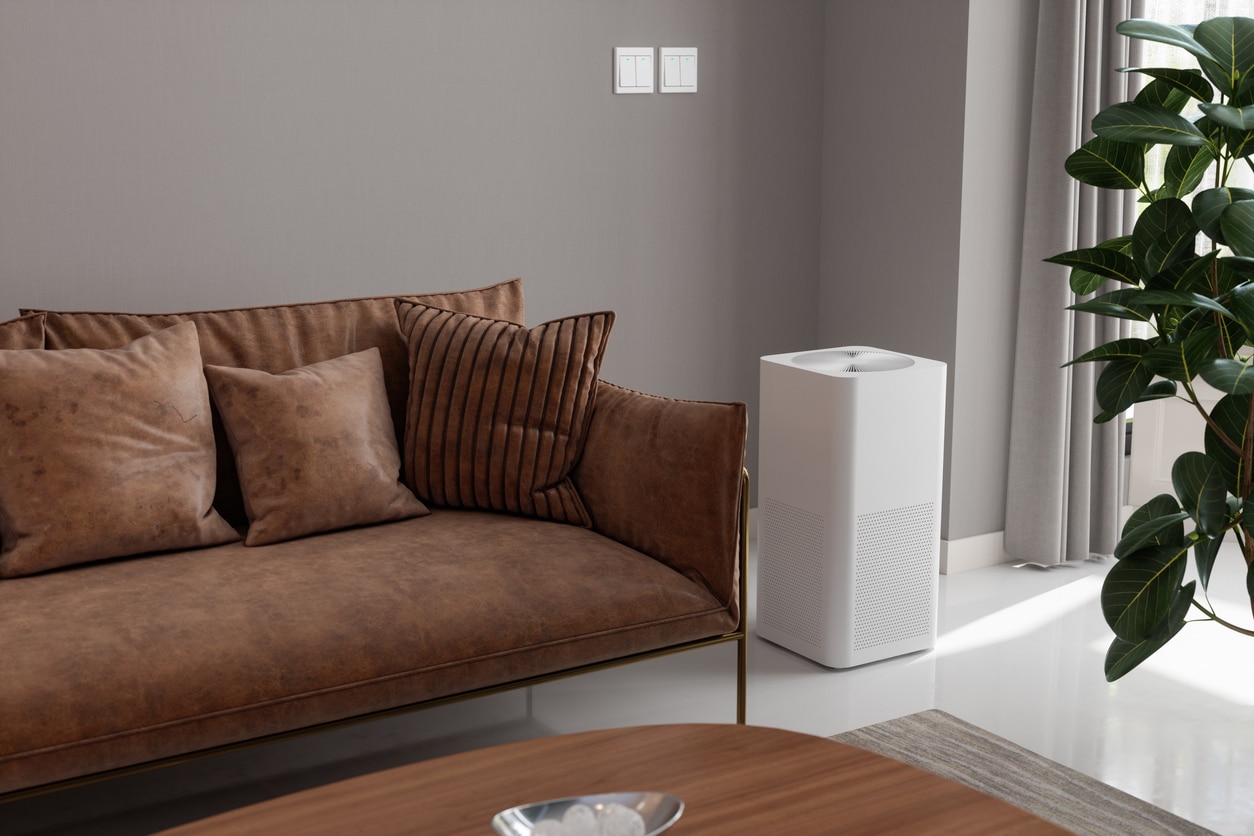Indoor air quality (IAQ) is crucial for maintaining a healthy living environment, especially in Georgia, where varying climates and seasonal changes can impact indoor air. This guide will help you understand what IAQ is, why it matters, and how to manage it effectively in your home.
What is Indoor Air Quality (IAQ)
Indoor air quality refers to the condition of the air within and around buildings, particularly as it relates to the health and comfort of the occupants. Good IAQ involves managing indoor pollutants, ensuring proper ventilation, and maintaining comfortable humidity levels.
It is essential because most people spend a significant portion of their time indoors, especially at home. Poor IAQ can lead to various health issues and reduce the overall quality of life.
Importance of IAQ in Homes
Why should homeowners in Georgia care about IAQ? The answer lies in the direct impact that air quality has on health and well-being. Poor IAQ can cause or exacerbate a range of health problems, from mild irritations to severe respiratory diseases.
For families with children, the elderly, or individuals with preexisting health conditions, maintaining good IAQ is even more critical. Moreover, Georgia’s diverse climate, ranging from hot, humid summers to cooler winters, presents unique challenges for maintaining consistent IAQ throughout the year.
Common Indoor Air Pollutants
To effectively manage Indoor Air Quality (IAQ), it is essential to know the common indoor air pollutants that can compromise it. Here are the primary culprits:
- Particulate Matter: These are tiny particles or droplets in the air that can be inhaled, including dust, dirt, soot, and smoke. Sources include cooking, smoking, and using candles or fireplaces.
- Volatile Organic Compounds (VOCs): These are emitted as gases from certain solids or liquids, such as paints, cleaning supplies, pesticides, and building materials. They can cause short- and long-term adverse health effects.
- Biological Pollutants: Mold, dust mites, pet dander, bacteria, and viruses fall into this category. These pollutants thrive in damp and humid conditions, which are common in many parts of Georgia.
Health Effects of Poor Indoor Air Quality
Poor indoor air quality can have serious consequences on health, especially for vulnerable populations like children, the elderly, and those with existing health conditions. Understanding these effects is the first step in taking action to improve the air you breathe at home.
Respiratory Issues
One of the most immediate effects of poor Indoor Air Quality is respiratory discomfort. Exposure to pollutants like particulate matter and VOCs can lead to:
- Coughing and Sneezing: These are common reactions to irritants in the air, such as dust, pollen, and smoke.
- Shortness of Breath: Particulates and chemical vapors can cause difficulty in breathing, especially for individuals with asthma or other lung conditions.
- Wheezing and Chest Tightness: These symptoms often result from chronic exposure to poor air quality and can be particularly severe for asthmatics.
Allergies and Asthma
Allergens such as mold spores, dust mites, and pet dander can trigger allergic reactions and asthma attacks. Key health effects include:
- Allergic Rhinitis: Symptoms include a runny nose, itchy eyes, and sinus congestion. These symptoms are often seasonal but can be persistent with continuous exposure to allergens.
- Asthma Attacks: Poor Indoor Air Quality can exacerbate asthma, leading to increased frequency and severity of attacks. Managing triggers is crucial for asthmatic individuals.
Long-term Health Risks
Chronic exposure to poor indoor air can lead to severe long-term health problems, such as:
- Chronic Obstructive Pulmonary Disease (COPD): Long-term exposure to pollutants can contribute to the development of COPD, characterized by long-term breathing problems and poor airflow.
- Cardiovascular Disease: Studies have linked prolonged exposure to particulate matter with increased risks of heart attacks and strokes.
- Cancer: Some VOCs, including formaldehyde and benzene, are known carcinogens. Long-term exposure increases the risk of developing certain types of cancer.
Sources of Indoor Air Pollution
Knowing where indoor air pollutants come from is essential for controlling and improving Indoor Air Quality in your home. These sources can be varied, often coming from everyday items and activities.
Household Products and Chemicals
Common household items are significant sources of indoor air pollution. These include:
- Cleaning Supplies: Many cleaning products release VOCs, which can irritate the eyes, nose, and throat and can cause headaches and other health issues.
- Paints and Solvents: These products can emit harmful gases for a long time after they are applied. Using low-VOC or VOC-free options can help mitigate this.
- Pesticides: These chemicals are used to control pests but can also contribute to indoor air pollution. They can cause both short-term effects like headaches and dizziness and long-term health problems.
Building Materials
Materials used in constructing and furnishing your home can release pollutants into the air:
- Asbestos: Found in older homes, asbestos fibers can cause serious lung conditions, including cancer.
- Formaldehyde: This chemical is often found in pressed wood products and can cause respiratory issues and other health problems.
- Lead: Older homes may still have lead-based paints, which can cause severe health issues, especially in children.
Outdoor Pollutants
Pollutants from outside can easily make their way indoors, impacting IAQ:
- Vehicle Emissions: Living near busy roads or highways can lead to increased levels of outdoor pollutants like nitrogen dioxide and carbon monoxide inside your home.
- Pollen: Seasonal allergens can enter your home through open windows and doors, affecting those with allergies.
- Industrial Pollutants: Proximity to factories or industrial areas can increase the levels of harmful pollutants in your home.
Assessing Indoor Air Quality (IAQ) in Your Home
Assessing indoor air quality is the first step toward ensuring a healthier living environment. Recognizing signs of poor IAQ and utilizing effective testing methods can help you identify and address issues promptly.
Signs of Poor Indoor Air Quality
Several indicators suggest that the air quality in your home might be compromised:
- Odors: Persistent, unpleasant smells that don’t go away despite cleaning and ventilation may indicate poor air quality.
- Visible Mold Growth: Mold is a significant sign of poor IAQ, especially if it reappears after cleaning.
- Dust Buildup: Excessive dust accumulation, particularly around vents and on surfaces, can be a red flag.
- Health Symptoms: Recurring respiratory issues, headaches, dizziness, or allergic reactions can all point to poor indoor air quality.
Simple Indoor Air Quality Testing Methods
You can begin assessing your home’s air quality with some basic, cost-effective methods:
- DIY Test Kits: Available at most home improvement stores, these kits can test for common pollutants like radon, mold, and VOCs.
- Carbon Monoxide Detectors: Installing these detectors helps ensure that this dangerous gas is not present in your home.
- Humidity Monitors: These devices can help you keep track of your indoor humidity levels, which can affect mold growth and overall IAQ.
Professional IAQ Assessments
For a comprehensive evaluation, consider hiring professionals who specialize in IAQ:
- Detailed Analysis: Professionals use advanced tools to measure a wide range of pollutants, including particulate matter, VOCs, and biological contaminants.
- Customized Solutions: Based on their findings, experts can recommend specific measures to improve your home’s air quality.
- Peace of Mind: Professional assessments provide a thorough understanding of your home’s IAQ and help ensure that all potential issues are identified and addressed.
Improving Ventilation
Proper ventilation is vital for maintaining good indoor air quality. It helps to remove pollutants, control humidity, and provide a steady supply of fresh air.
Importance of Ventilation
Why is ventilation so crucial? Here are key reasons:
- Pollutant Removal: Ventilation helps to expel indoor pollutants, including VOCs, particulate matter, and carbon dioxide.
- Moisture Control: Effective ventilation reduces humidity levels, preventing mold growth and other moisture-related problems.
- Oxygen Supply: Ensuring a continuous supply of fresh air keeps indoor environments comfortable and healthy.
Natural Ventilation Techniques
Using natural ventilation can be an effective and cost-efficient way to improve IAQ:
- Opening Windows and Doors: This allows fresh air to enter and stale air to exit, improving overall air quality.
- Cross Ventilation: Create airflow by opening windows on opposite sides of a room or building. This method enhances the movement of fresh air.
- Using Vents and Louvers: These can be installed in walls and roofs to facilitate airflow without compromising security or weatherproofing.
Mechanical Ventilation Options
For more consistent and controlled ventilation, consider mechanical systems:
- Exhaust Fans: Installed in kitchens and bathrooms, exhaust fans help to remove moisture, odors, and contaminants directly from these spaces.
- Whole-House Ventilation Systems: These systems, including energy recovery ventilators (ERVs) and heat recovery ventilators (HRVs), provide fresh air throughout the home while conserving energy.
- Air Handling Units: These units can be part of your HVAC system, ensuring that air is properly circulated, filtered, and conditioned.
Air Purification Methods
In addition to ventilation, air purification is a critical step in maintaining clean indoor air. Various methods and devices can help remove contaminants and improve air quality.
Air Purifiers: Types and Benefits
Air purifiers come in different types, each with its own set of benefits:
- HEPA Filters: High-Efficiency Particulate Air (HEPA) filters are highly effective at capturing small particles like dust, pollen, and pet dander. They are ideal for people with allergies or asthma.
- Activated Carbon Filters: These filters are excellent at removing odors, VOCs, and other gaseous pollutants. They are often used in conjunction with HEPA filters for comprehensive air purification.
- UV Air Purifiers: Using ultraviolet light, these purifiers kill bacteria, viruses, and mold spores, reducing biological contaminants in the air.
- Ionic Air Purifiers: These devices emit negative ions that attach to particles, causing them to settle out of the air or get trapped in a filter. However, they can produce ozone, which may be harmful in high concentrations.
Plants for Natural Air Purification
Certain houseplants can naturally improve indoor air quality by absorbing pollutants and releasing oxygen. Some effective plants include:
- Spider Plant: Known for its ability to remove formaldehyde and xylene.
- Peace Lily: Effective at filtering out VOCs and can also reduce mold spores.
- English Ivy: Excellent at reducing airborne mold and other allergens.
Maintenance of Air Purifiers
To ensure your air purifiers work effectively, regular maintenance is essential:
- Change Filters Regularly: HEPA and activated carbon filters should be replaced according to the manufacturer’s recommendations, usually every 6-12 months.
- Clean the Unit: Dust and wipe down the exterior of the purifier to prevent buildup that could impede performance.
- Monitor Air Quality: Use IAQ monitors to track improvements and determine when maintenance is needed.
Controlling Humidity Levels
Maintaining the right humidity levels in your home is crucial for both comfort and health. It helps prevent mold growth, dust mite proliferation, and other moisture-related problems.
Ideal Humidity Range
The ideal indoor humidity level should be between 30% and 50%. Levels below 30% can cause dryness and irritation, while levels above 50% can encourage mold growth and dust mites.
Using Dehumidifiers and Humidifiers
To maintain optimal humidity levels, you might need to use dehumidifiers or humidifiers depending on the season and your local climate.
- Dehumidifiers: These devices remove excess moisture from the air. They are particularly useful in humid climates or during the summer months. Place them in damp areas like basements or bathrooms to prevent mold and mildew.
- Humidifiers: These add moisture to the air, which is especially helpful in dry climates or during winter when indoor heating can reduce humidity levels. Use them in living areas and bedrooms to maintain comfort and prevent respiratory issues.
Managing Humidity in Different Seasons
Different seasons require different strategies to manage indoor humidity effectively:
- Winter: Indoor heating can dry out the air. Use humidifiers to maintain comfortable humidity levels and prevent dry skin and respiratory problems.
- Summer: High humidity levels are common in the summer. Use dehumidifiers to reduce moisture, especially in areas prone to dampness.
- Spring and Fall: These transitional seasons can have varying humidity levels. Monitor indoor humidity and adjust the use of humidifiers or dehumidifiers accordingly.
Reducing Chemical Pollutants
Reducing chemical pollutants in your home is crucial for maintaining good indoor air quality. Everyday products and activities can release harmful chemicals, but there are strategies to minimize their impact.
Choosing Low-VOC Products
Volatile organic compounds (VOCs) are harmful chemicals found in many household products. To reduce exposure, choose low-VOC or VOC-free options:
- Paints and Finishes: Opt for low-VOC or zero-VOC paints, stains, and varnishes.
- Cleaning Products: Use natural or green cleaning products that are free from harsh chemicals.
- Building Materials: When renovating, select low-VOC materials, including flooring, adhesives, and insulation.
Safe Storage of Chemicals
Proper storage of chemicals can prevent the release of harmful fumes into your home:
- Seal Containers Tightly: Always close lids tightly on cleaning products, paints, and other chemicals.
- Store in Well-Ventilated Areas: Keep chemicals in a garage, shed, or other well-ventilated spaces, away from living areas.
- Dispose of Hazardous Waste Properly: Follow local guidelines for disposing of paints, solvents, and other hazardous materials to avoid contamination.
Alternatives to Chemical Cleaners
Using natural alternatives to chemical cleaners can improve IAQ:
- Vinegar and Baking Soda: These are effective for cleaning surfaces, deodorizing, and unclogging drains without releasing harmful chemicals.
- Essential Oils: Lemon, tea tree, and lavender oils can be used for their antimicrobial properties and pleasant scents.
- Microfiber Cloths: These can clean surfaces effectively without the need for additional cleaning products.
Managing Biological Pollutants
Biological pollutants such as mold, dust mites, and pet dander can significantly affect indoor air quality. Managing these pollutants is crucial for maintaining a healthy home environment.
Preventing Mold Growth
Mold thrives in damp, humid conditions. To prevent mold growth, follow these tips:
- Control Humidity: Keep indoor humidity levels below 50%. Use dehumidifiers and air conditioners to maintain this range.
- Fix Leaks Promptly: Repair any leaks in roofs, walls, or plumbing to prevent moisture buildup.
- Ventilate Damp Areas: Ensure proper ventilation in bathrooms, kitchens, and basements. Use exhaust fans and open windows to reduce moisture.
Controlling Dust Mites
Dust mites are common allergens that can exacerbate asthma and allergies. To control dust mites:
- Wash Bedding Frequently: Use hot water to wash sheets, pillowcases, and blankets weekly.
- Use Dust-Mite-Proof Covers: Encase mattresses, pillows, and box springs in dust-mite-proof covers.
- Vacuum Regularly: Use a vacuum with a HEPA filter to remove dust and allergens from carpets and upholstery.
Pet Dander and Allergen Control
Pet dander can be a significant indoor allergen. To manage pet dander:
- Groom Pets Regularly: Bathe and groom pets frequently to reduce dander.
- Create Pet-Free Zones: Keep pets out of bedrooms and other areas where you spend a lot of time.
- Use Air Purifiers: Place air purifiers with HEPA filters in rooms where pets are allowed to help reduce dander.
IAQ Considerations for Specific Rooms
Different rooms in your home have unique IAQ challenges. Tailoring your approach to each room can significantly improve overall indoor air quality.
Bedrooms: Clean Air for Better Sleep
Good air quality in bedrooms is essential for restful sleep and overall health:
- Use Air Purifiers: Place a HEPA air purifier in your bedroom to filter out dust, pollen, and other airborne particles.
- Wash Bedding Frequently: Launder sheets, pillowcases, and blankets weekly in hot water to eliminate dust mites and allergens.
- Keep Windows Closed During Allergy Seasons: Prevent outdoor allergens from entering by keeping windows closed and using air conditioning.
Kitchens: Ventilation During Cooking
Cooking can release pollutants such as smoke, grease, and VOCs. Proper ventilation is key:
- Use Range Hoods: Install a range hood that vents outside to capture and remove cooking emissions.
- Open Windows: If you don’t have a range hood, open windows to improve airflow and reduce indoor pollution.
- Avoid Frying: Frying foods can release significant amounts of pollutants. Opt for baking, steaming, or boiling instead.
Bathrooms: Managing Moisture and Mold
Bathrooms are prone to high humidity, making mold prevention critical:
- Use Exhaust Fans: Run exhaust fans during and after showers to remove moisture and reduce humidity levels.
- Fix Leaks Immediately: Repair any plumbing leaks to prevent mold growth and structural damage.
- Clean Regularly: Use mold-inhibiting cleaners on tiles, grout, and other surfaces prone to mold.
FAQs on Indoor Air Quality
- What are the main causes of poor indoor air quality (IAQ)?
Poor IAQ is mainly caused by indoor pollutants such as particulate matter, volatile organic compounds (VOCs), mold, dust mites, and pet dander. These can originate from household products, building materials, and outdoor pollutants.
- How often should IAQ be tested?
It is recommended to test your indoor air quality at least once a year, especially if there are ongoing health issues, renovations, or changes in your home environment.
- What are the best air purifiers for homes?
The best air purifiers for homes typically feature HEPA filters, which are effective at capturing small particles like dust, pollen, and pet dander. Models with activated carbon filters can also help remove odors and VOCs.
- How can I reduce chemical pollutants in my home?
To reduce chemical pollutants, choose low-VOC or VOC-free products, store chemicals properly in well-ventilated areas, and use natural cleaning alternatives like vinegar and baking soda.
- What are the signs of poor IAQ?
Signs of poor IAQ include persistent odors, visible mold growth, excessive dust, and recurring health symptoms such as headaches, respiratory issues, and allergic reactions.
Maintaining good indoor air quality is essential for a healthy home environment. By understanding the sources of indoor pollutants and implementing strategies to manage them, you can significantly improve the air you and your family breathe.
Whether it’s through enhancing ventilation, using air purifiers, or controlling humidity levels, each step contributes to better IAQ. For Georgia residents, addressing local pollutants and seasonal variations is crucial. Regularly assessing and improving your home’s air quality will ensure a healthier, more comfortable living space for everyone.
Do you have any additional tips for maintaining good indoor air quality in your home? Share your thoughts and experiences in the comments below!











